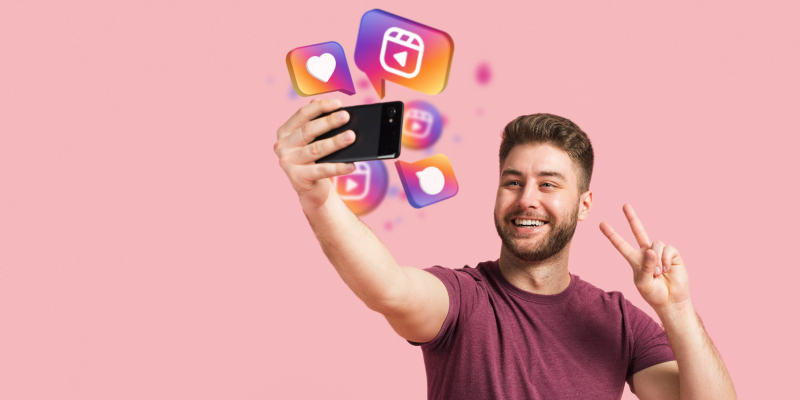

Social media advertising has become vital for small businesses trying to reach a wider audience, interact with consumers, and increase sales in the digital era. Facebook and Instagram are two of the most potent social media advertising platforms since they include many features and tools to help you make the most out of your marketing campaigns. Following this in-depth guide by a leading Digital marketing agency, you will learn all you need to know about using Facebook and Instagram ads to grow your small business.
Social media has changed how businesses interact with their audience in the last ten years. With billions of users globally, social media sites like Facebook and Instagram present unmatched chances to connect with potential clients. Businesses may target particular demographics, hobbies, and behaviors with social media advertising, ensuring the most likely to interact with your company see your adverts.
You can target your audience with precision with Facebook and Instagram advertisements by providing information about their demographics, geography, interests, and habits.
Cost-Effective: Social media advertising is frequently more economical and yields a larger return on investment when compared to traditional advertising techniques.
Measurable Outcomes: Equipped with powerful analytics capabilities, you can monitor the efficacy of your advertisements in real time and enhance your campaigns by making data-driven decisions.
Enhanced business Awareness: You can reach new audiences and greatly increase the visibility of your business with social media ads.

Creating a Business Page on Facebook You must first create a Facebook Business Page before you can begin running Facebook advertisements. This will be the central location for all your advertising activities and allow you to engage with your audience more effectively.
Select Your Goal: Facebook provides a range of campaign goals, such as lead generation, conversions, app installs, engagement, traffic, brand exposure, and video views. Choose the choice that best fits your company's objectives.
Identify Your Audience: Use Facebook's comprehensive targeting features to identify your audience. Users can be targeted according to their age, gender, location, hobbies, and actions.
Set a daily or lifetime budget and decide how much you want to spend on your advertising campaign. Your advertisements can also be set to run at particular times.
Design Your Ad: Use photos, videos, and attention-grabbing language to create visually appealing advertisements. Ensure your brand's voice and message are reflected in your advertisements.
Monitor and Optimize: After your ad campaign is live, use Facebook's analytics tools to track its effectiveness. To enhance outcomes, modify your budget, targeting, and ad creatives as necessary.

Visual Advertisements: These simple yet successful advertisements draw in viewers with sharp visuals. Videos may be used to demonstrate your goods or services in action and are a very engaging form of advertising.
Carousel ads: are great for presenting various products because they let you include several photos or videos in one ad.
Collection advertisements: Specifically made for mobile devices, collection advertisements have product images after a cover image or video.
Lead Ads: advertisements are designed to capture user data, like email addresses, straight from the screen.
Connecting Your Facebook Account to Instagram You must connect your Instagram account to your Facebook Business Page to run ads on Instagram. Thanks to this integration, you may use the Facebook Advertisements Manager to manage your Instagram advertisements.
Select Your Goal: Similar to Facebook, Instagram provides a range of campaign goals, such as conversions, app installs, reach, brand exposure, and traffic and engagement.
Choose Your Ad Format: Instagram offers a variety of ad forms, such as carousels, stories, photos, and video advertisements.
Determine Who Your Audience Is: Reach your desired audience by using Instagram's targeting choices, which are based on behaviors, interests, and demographics.
Establish Your Timetable and Budget: Establish the duration of your campaign and decide on your ad spend. It is also up to you to decide whether to run your adverts constantly or only for a set amount of time.
Make Your Advertisement: Create eye-catching advertisements that appeal to your target market. Employ attention-grabbing content, films, and high-quality photos to draw viewers in.

Photo ads: These communicate the story of your brand through stunning photos. Videos lasting up to 60 seconds are ideal for promoting products or sharing a brand's history.
Carousel ads: These let viewers swipe between several pictures or videos.
Stories Ads: Immersive full-screen advertisements that show up in between users' stories. Recommended Practices for Instagram and Facebook Ads Creating Stunning Advertising Creatives.
High-quality Visuals: Make your advertisements stand out using high-quality photos and videos.
Concise and Clear text: Create engaging advertising text with a clear call to action that effectively communicates your message.
Consistent Branding: Make sure your advertisements' tone, aesthetic, and messaging align with your brand. Selecting the Appropriate Audience.
Custom Audiences: Build audiences specifically for your website's visitors or email lists of current customers.
Lookalike Audiences: To connect with new individuals who resemble your current clientele, utilize lookalike audiences.
Detailed Targeting: To focus your audience on certain demographics, hobbies, and behaviors, make use of Facebook and Instagram's detailed targeting features. Getting Your Advertising Campaigns Optimized
A/B Testing: To determine which ad creatives, targeting choices, and bidding techniques perform best, compare them using A/B testing.
Track Performance: Check your ad performance indicators regularly, including return on ad expenditure, click-through rates, and conversion rates.
Conversion Rate: The proportion of visitors that finished an intended action, like buying something or subscribing to a newsletter.
Cost Per convert: The amount you pay for each convert through advertising. The revenue from your advertisements divided by the amount spent on them is known as return on ad spend, or ROAS.
You can display advertisements to users who have interacted with your brand through retargeting. This is a really powerful tactic for turning curious users into paying clients.
A code called the Facebook Pixel is added to your website to track user interactions and collect important data. You can utilize this data to generate more focused audiences and optimize your advertising efforts.
Dynamic Ads Users interested in your website or app will automatically see the appropriate products thanks to dynamic ads. Your conversion rates can be greatly increased by using this tailored strategy.
To get the most out of it, consider combining your social media advertising with other digital marketing techniques like SEO services and PPC advertising.
Example 1: Small Enterprise Local bakery A Small Business A advertised their new line of gluten-free goods on Instagram. They experienced a 30% spike in sales in only one month by focusing on health-conscious consumers in the neighborhood.
Example 2: B Small Business Facebook lookalike audiences were leveraged by Small Business B, an online clothes store, to expand its customer base. Their advertising effort increased website traffic by 40% and sales by 20%.
Example 3: Small Business C Small Business C, a fitness studio, used retargeting ads on Facebook and Instagram to re-engage users who had visited their website but didn't sign up for a class. This strategy led to a 25% increase in new memberships.
Small businesses have many opportunities to expand and thrive through social media advertising on sites like Facebook and Instagram. You may accomplish amazing results by learning the subtleties of these platforms, creating captivating ad creatives, and consistently refining your campaigns.
Recall that there isn't a one-size-fits-all strategy for social media advertising. Constant testing, learning, and adaptation are necessary to keep ahead of the competition. This comprehensive guide on Facebook and Instagram ads for small businesses can assist you in navigating the always-changing field of social media marketing, regardless of whether you're just getting started or trying to improve your current tactics.